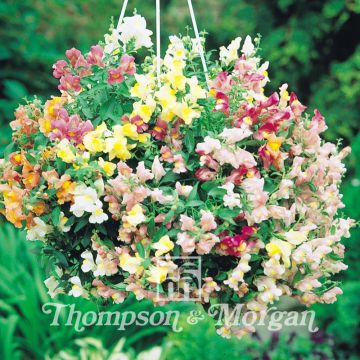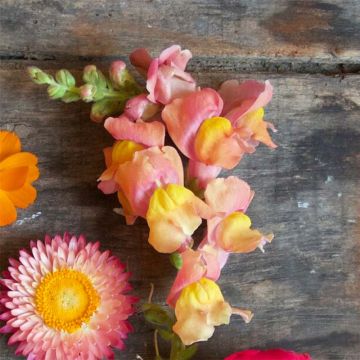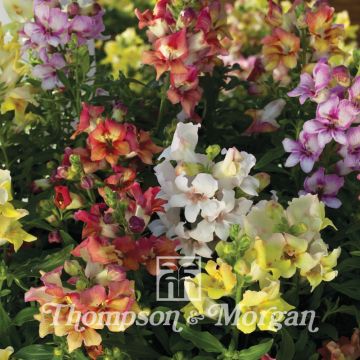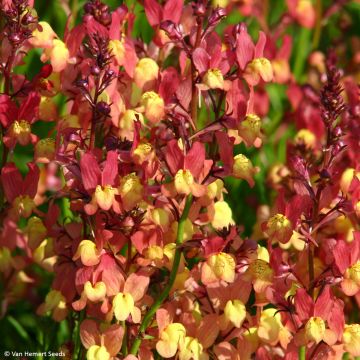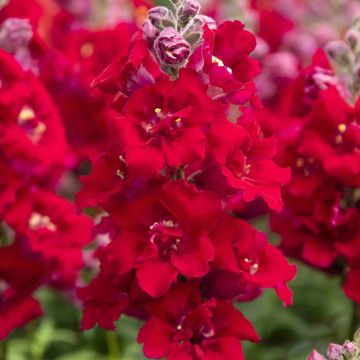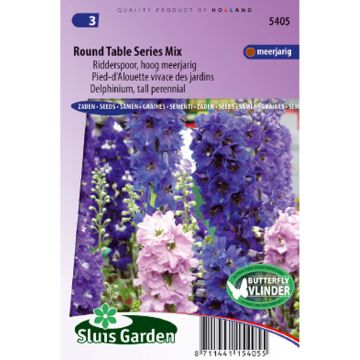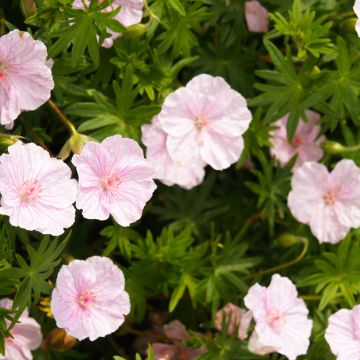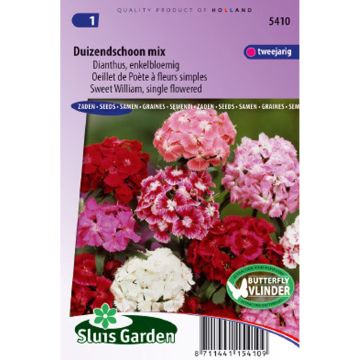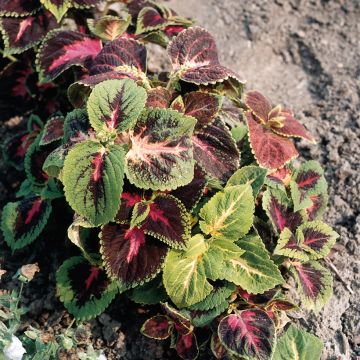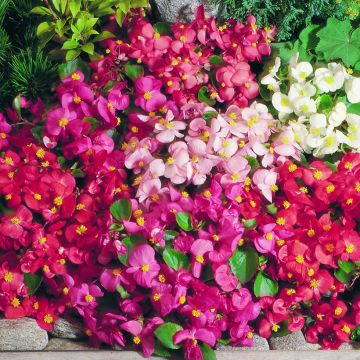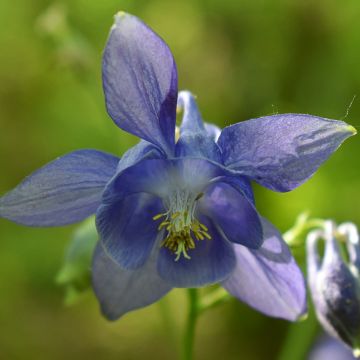

Snapdragon Appleblossom seeds - Antirrhinum majus
Snapdragon Appleblossom seeds - Antirrhinum majus
Antirrhinum x majus Appleblossom
Snapdragon, Garden Snapdragon
Why not try an alternative variety in stock?
View all →This plant carries a 6 months recovery warranty
More information
We guarantee the quality of our plants for a full growing cycle, and will replace at our expense any plant that fails to recover under normal climatic and planting conditions.
Seed-only orders are dispatched by sealed envelope. The delivery charge for seed-only orders is €3.90.
Does this plant fit my garden?
Set up your Plantfit profile →
Description
Antirrhinum majus ‘Appleblossom’, commonly known as snapdragon, is appreciated for its long pastel floral spikes that enhance borders from June to September. Its generous flowering and ability to attract bees make it an excellent choice for creating a gentle natural corner. Suitable for both open ground and pots, its fragrant flowers are also perfect for creating charming bouquets.
Native to the Mediterranean basin and Southern Europe, Antirrhinum majus belongs to the Scrophulariaceae family. This cultivar, ‘Appleblossom’, stands out with delicately bicoloured flowers, combining pale pink and creamy white, enhanced by a small yellow throat. The plant reaches a height of 80 to 90 cm in a few months. It has a slender silhouette and lanceolate bright green leaves. Its flowers are clustered in dense spikes on straight stems. With a prolonged flowering period from summer to early autumn, this Snapdragon is highly appreciated in cottage gardens and floral arrangements. It is half-hardy and tolerates temperatures down to -6°C but should be protected during harsh winters. The plant produces a large number of seeds that can self-sow randomly in the garden. Plants from self-sown seeds may not necessarily be identical to the mother plant.
Snapdragon ‘Appleblossom’ fits perfectly in romantic or rustic borders. Its proud flowering can be complemented by hybrid mulleins like 'Pink Domino' and 'Southern Charm', Cosmos 'Sensation Purity' or even pink yarrows. It can also be paired with Old Roses to create romantic scenes in the garden.
The Snapdragon owes its common name to the particular shape of its flowers which, when pinched, resemble throats.
Attention, seeds reserved for experienced gardeners used to sowing very fine seeds. These seeds are as fine as dust, barely visible to the naked eye.
Report an error about the product description
Flowering
Foliage
Plant habit
Botanical data
Antirrhinum
x majus
Appleblossom
Plantaginaceae
Snapdragon, Garden Snapdragon
Cultivar or hybrid
Other Antirhinum - Snapdragon seeds
Planting and care
Sow Antirrhinum majus Appleblossom from January to March on the surface of a well-drained seed compost. Do not cover the seeds. Place in a propagator or a seed tray in a plastic bag kept at 20-25°C until germination, which usually takes 10 to 21 days. Light aids germination. Prick out the seedlings when they are large enough to handle into 8 cm pots or trays. Acclimatise the plants gradually to cooler conditions for a few weeks before planting out after all risk of frost, spacing them 23 to 30 cm apart.
Snapdragons thrive in fertile, well-drained, well-worked soil in full sun. The tall snapdragon is not very hardy (-6/-7°C) so it is often grown as an annual or biennial plant. However, it is not uncommon to see snapdragons withstand several not too severe winters, becoming more susceptible to rust... To try to preserve a special variety, shelter the plants from severe winter frosts by improving soil drainage and covering the crowns with a thick mat of leaves or dry foliage: they will come back in spring and bloom earlier.
Sowing period
Intended location
This item has not been reviewed yet - be the first to leave a review about it.
Flower seeds
Haven't found what you were looking for?
Hardiness is the lowest winter temperature a plant can endure without suffering serious damage or even dying. However, hardiness is affected by location (a sheltered area, such as a patio), protection (winter cover) and soil type (hardiness is improved by well-drained soil).

Photo Sharing Terms & Conditions
In order to encourage gardeners to interact and share their experiences, Promesse de fleurs offers various media enabling content to be uploaded onto its Site - in particular via the ‘Photo sharing’ module.
The User agrees to refrain from:
- Posting any content that is illegal, prejudicial, insulting, racist, inciteful to hatred, revisionist, contrary to public decency, that infringes on privacy or on the privacy rights of third parties, in particular the publicity rights of persons and goods, intellectual property rights, or the right to privacy.
- Submitting content on behalf of a third party;
- Impersonate the identity of a third party and/or publish any personal information about a third party;
In general, the User undertakes to refrain from any unethical behaviour.
All Content (in particular text, comments, files, images, photos, videos, creative works, etc.), which may be subject to property or intellectual property rights, image or other private rights, shall remain the property of the User, subject to the limited rights granted by the terms of the licence granted by Promesse de fleurs as stated below. Users are at liberty to publish or not to publish such Content on the Site, notably via the ‘Photo Sharing’ facility, and accept that this Content shall be made public and freely accessible, notably on the Internet.
Users further acknowledge, undertake to have ,and guarantee that they hold all necessary rights and permissions to publish such material on the Site, in particular with regard to the legislation in force pertaining to any privacy, property, intellectual property, image, or contractual rights, or rights of any other nature. By publishing such Content on the Site, Users acknowledge accepting full liability as publishers of the Content within the meaning of the law, and grant Promesse de fleurs, free of charge, an inclusive, worldwide licence for the said Content for the entire duration of its publication, including all reproduction, representation, up/downloading, displaying, performing, transmission, and storage rights.
Users also grant permission for their name to be linked to the Content and accept that this link may not always be made available.
By engaging in posting material, Users consent to their Content becoming automatically accessible on the Internet, in particular on other sites and/or blogs and/or web pages of the Promesse de fleurs site, including in particular social pages and the Promesse de fleurs catalogue.
Users may secure the removal of entrusted content free of charge by issuing a simple request via our contact form.
The flowering period indicated on our website applies to countries and regions located in USDA zone 8 (France, the United Kingdom, Ireland, the Netherlands, etc.)
It will vary according to where you live:
- In zones 9 to 10 (Italy, Spain, Greece, etc.), flowering will occur about 2 to 4 weeks earlier.
- In zones 6 to 7 (Germany, Poland, Slovenia, and lower mountainous regions), flowering will be delayed by 2 to 3 weeks.
- In zone 5 (Central Europe, Scandinavia), blooming will be delayed by 3 to 5 weeks.
In temperate climates, pruning of spring-flowering shrubs (forsythia, spireas, etc.) should be done just after flowering.
Pruning of summer-flowering shrubs (Indian Lilac, Perovskia, etc.) can be done in winter or spring.
In cold regions as well as with frost-sensitive plants, avoid pruning too early when severe frosts may still occur.
The planting period indicated on our website applies to countries and regions located in USDA zone 8 (France, United Kingdom, Ireland, Netherlands).
It will vary according to where you live:
- In Mediterranean zones (Marseille, Madrid, Milan, etc.), autumn and winter are the best planting periods.
- In continental zones (Strasbourg, Munich, Vienna, etc.), delay planting by 2 to 3 weeks in spring and bring it forward by 2 to 4 weeks in autumn.
- In mountainous regions (the Alps, Pyrenees, Carpathians, etc.), it is best to plant in late spring (May-June) or late summer (August-September).
The harvesting period indicated on our website applies to countries and regions in USDA zone 8 (France, England, Ireland, the Netherlands).
In colder areas (Scandinavia, Poland, Austria...) fruit and vegetable harvests are likely to be delayed by 3-4 weeks.
In warmer areas (Italy, Spain, Greece, etc.), harvesting will probably take place earlier, depending on weather conditions.
The sowing periods indicated on our website apply to countries and regions within USDA Zone 8 (France, UK, Ireland, Netherlands).
In colder areas (Scandinavia, Poland, Austria...), delay any outdoor sowing by 3-4 weeks, or sow under glass.
In warmer climes (Italy, Spain, Greece, etc.), bring outdoor sowing forward by a few weeks.


































